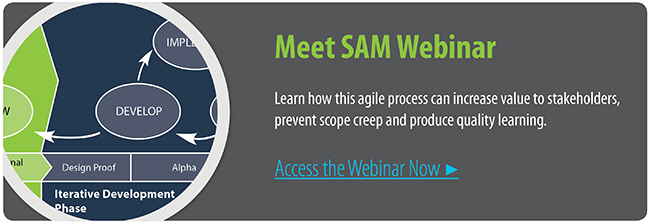Blog
No Couch Potatoes: A Case for Making Training ACTIVE
by Ellen Burns, instructional writer/designer | @EllenBJohnson I had the pleasure of visiting a client in Texas a few short weeks ago to kick off a ...


3 Fun Factors to a Successful e-Learning Project Kickoff Meeting
By Ellen Burns-Johnson | February 13, 2014 | Custom Learning | 0 Comments
by Ellen Burns, instructional writer/designer | @EllenBJohnson
.png?width=120&height=120&name=ellen(250).png) I had the pleasure of visiting a client in Texas a few short weeks ago to kick off a new e-learning project. Not only was the weather much more pleasurable than what we’ve lately been experiencing in Minnesota, but the meetings themselves were productive and fun.
I had the pleasure of visiting a client in Texas a few short weeks ago to kick off a new e-learning project. Not only was the weather much more pleasurable than what we’ve lately been experiencing in Minnesota, but the meetings themselves were productive and fun.
That’s right. I said FUN! The kickoff meeting (aka Savvy Start) is the brainstorming event in the SAM (Successive Approximation Model) process. It’s also one of my favorite project components. During a Savvy Start, we meet with stakeholders and SMEs from the client’s team and our goal is to uncover the desired behaviors we want to focus on in the training.
While brainstorming and discussing those behaviors, we sketch out initial ideas for interactions that might meet the needs of the learner and the organization. Then, we create prototypes of the sketches the team feels could work best. Next, we present the prototypes and gather feedback from the Subject Matter Experts (SMEs), stakeholders and even learners. And, we do it all onsite so we can get to know the people involved in the project!
While I think the kickoff meetings are fun, that isn’t to say I don’t find them somewhat stressful. I do, because there’s risk involved. There’s always a chance that the client won’t like our ideas, or that we’ll struggle to communicate effectively. There’s always the lurking, irrational fear that I’ll say something so outrageously stupid that everyone in the room will stare at me, wide-eyed and aghast. (This last one never really leaves you, no matter how many Savvy Starts you’ve attended.)
But, a lot of activities that human beings find to be fun include a level of risk. Would the Olympics be fun to watch if there were no chance your favorite competitor could lose or take a tumble onto the ice? No! Risk makes things interesting and creates the space where real fun can exist.
Here are 3 ways you can guarantee your kickoff meeting will be a rewarding experience.
Fun Factor #1: Have rich conversations
One of the key parts of a Savvy Start is listening to, and getting to know, your project team. When you're trying to build behavior-focused training, you need the SMEs, stakeholders, managers and recent learners to explain the processes, actions, and ideas on which they need training.
Unfortunately, it can seem like you and your SMEs are speaking wholly different languages. If you are unable to communicate effectively with your SMEs, you may be unable to get the information you need to really move forward with your design.
You risk walking away with a distorted picture of the training needs. You might needlessly spend time in (failed) design iterations before you’re able to agree on a solution simply due to an initial communication gap.
You can avoid this by taking steps to create rich conversations at the project kickoff:
-
Come with a list of questions―a huge arsenal of questions. You probably won’t ask
every question on your list, and you don’t have to. If you get stuck, keep pulling from your list of questions until you start to get a picture of the realistic challenge your learners should be facing in the training. -
Sometimes I find it helpful to create a CCAF map on a piece of paper alongside my regular notes. I keep asking questions until I have good ideas in each of the 4 categories. An example CCAF map is on the right.
Fun Factor #2: Prototype

Prototyping as part of your kickoff session allows you conclude your meeting with purpose. If you prototyped during your kickoff, you already tested ideas and gathered feedback. You can leave that meeting confidently knowing where your design is headed next.
The main concern about prototyping onsite during a Savvy Start is the amount of time it takes to prototype. If you have asked the right questions, you should need no more than 2-3 hours to brainstorm ideas and complete a prototype for an interaction. It is so tempting to spend more time than this. I confess that I’ve done it occasionally. The devilish little perfectionist inside me wants to spend the time necessary to get it right.
However, my internal pragmatist knows that prototypes are not meant to be flawless. All you need to do is build enough to convey an idea of the interaction and verify that you’re headed in the right direction. This is why I like ZebraZapps for prototyping. If you need to set up something fast, you can build shortcuts for yourself while also conveying the way an interaction will “feel” when it’s complete.
No matter which authoring tool you use, it’s worth prototyping during your Savvy Start. Prototypes are fun to create, and if you set your stakeholders’ expectations appropriately, the discussions you’ll have about the prototypes will be a blast.
Fun Factor #3: Get emotionally invested in the success of the project
Okay, yes. This is obvious, right? Of course you should care about the success of your project. You want it to come in on time and preferably under budget. You want it to look nice and you want your stakeholders to like it.
But when I refer to “success” in this context, I’m not referring to budget and timeline. To me, a successful project is one that meets the original goal for the training. It’s one that actually changes how people perform.
I find it difficult to create the design for an activity without truly caring about whether or not it makes a difference. So my foremost goal during a Savvy Start is to get fired up. You are hard-pressed to find a more passionate group of people than a room full of experts who care about solving a problem. I like to think that I am as passionate about changing the behavior of learners as the SMEs and stakeholders are about solving the business problem. I use this feeling to guide my thinking and fuel my creativity.
There you have it—your Savvy Start recipe for fun. What are some ways you create a successful project kickoff meeting?
About Ellen Burns-Johnson
A former English and technology teacher, Ellen Burns-Johnson joined Allen Interactions in 2011. Since then, Ellen has designed e-learning interactions and written content for dozens of projects and clients, including Apple, Allstate, Hilton, Verizon, and the Department of Justice. Instructional topics included solution selling, software simulation, product sales, compliance training, customer service, and legal consulting skills.
Ellen’s professional interests include gamification, blended learning, interface design, and social media. A learning junkie, Ellen has been known to organize study groups in which colleagues meet to study new development software and build e-learning applications for fun. Connect with Ellen!



About the Author: Ellen Burns-Johnson
Ellen Burns-Johnson has over a decade of experience in the education and training industries. She has crafted the instructional strategy and design for dozens of major initiatives across diverse topics, from classroom safety to IT sales. Emphasizing collaboration and playfulness in her approach to creating learning experiences, Ellen’s work has earned multiple industry awards for interactivity and game-based design. Ellen is also a Certified Scrum Master® and strives to bring the principles of Agile to life in the L&D field. Whether a client is a Fortune 100 company or a local nonprofit, she believes that the best learning experiences are created through processes built on transparency between sponsors and developers, empirical processes, and respect for learners. Outside of her LXD work, Ellen plays video games (and sometimes makes them) and runs around the Twin Cities with her two mischievous dogs (ask for pictures).
Comments
Would you like to leave a comment?
Related Blog Posts

By: Ellen Burns-Johnson | Aug, 2014
Category: Custom Learning

Blog
Learner-Centered Design: 3 Quick Ideas for e-Learning
by Ellen Burns, instructional writer/designer | @EllenBJohnson I had the pleasure of visiting a client in Texas a few short weeks ago to kick off a ...
By: Ellen Burns-Johnson | May, 2014
Category: Custom Learning

Blog
Q&A: Three Quick Ideas for Creating Interactive e-Learning
by Ellen Burns, instructional writer/designer | @EllenBJohnson I had the pleasure of visiting a client in Texas a few short weeks ago to kick off a ...
By: Ellen Burns-Johnson | Apr, 2015
Category: Custom Learning, Strategic Consulting
